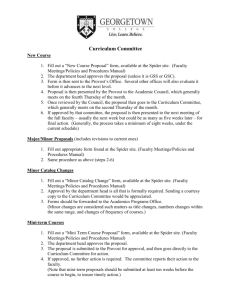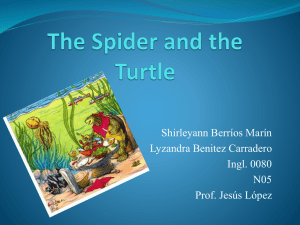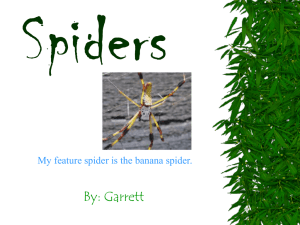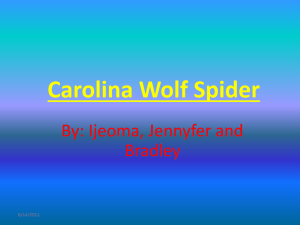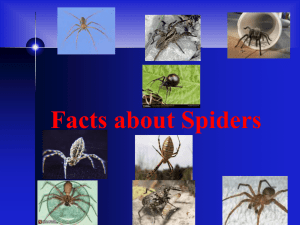Spiders and Their Webs
advertisement
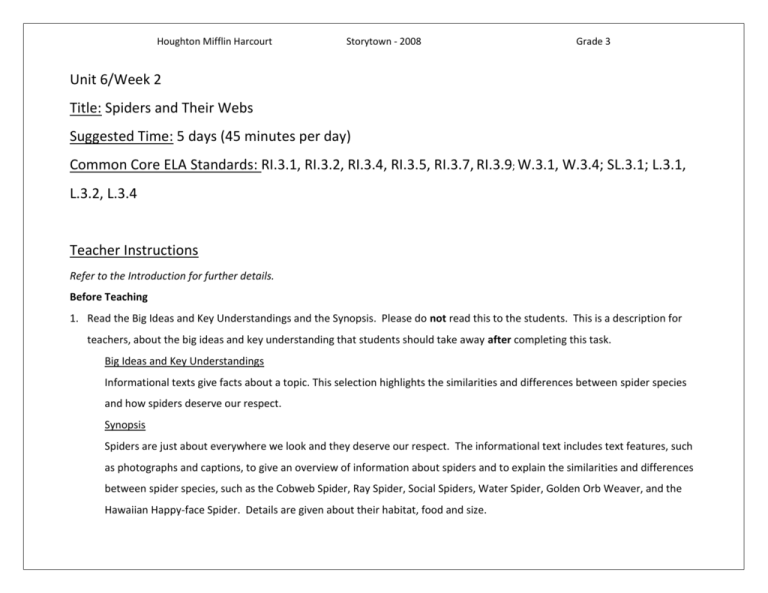
Houghton Mifflin Harcourt Storytown - 2008 Grade 3 Unit 6/Week 2 Title: Spiders and Their Webs Suggested Time: 5 days (45 minutes per day) Common Core ELA Standards: RI.3.1, RI.3.2, RI.3.4, RI.3.5, RI.3.7, RI.3.9; W.3.1, W.3.4; SL.3.1; L.3.1, L.3.2, L.3.4 Teacher Instructions Refer to the Introduction for further details. Before Teaching 1. Read the Big Ideas and Key Understandings and the Synopsis. Please do not read this to the students. This is a description for teachers, about the big ideas and key understanding that students should take away after completing this task. Big Ideas and Key Understandings Informational texts give facts about a topic. This selection highlights the similarities and differences between spider species and how spiders deserve our respect. Synopsis Spiders are just about everywhere we look and they deserve our respect. The informational text includes text features, such as photographs and captions, to give an overview of information about spiders and to explain the similarities and differences between spider species, such as the Cobweb Spider, Ray Spider, Social Spiders, Water Spider, Golden Orb Weaver, and the Hawaiian Happy-face Spider. Details are given about their habitat, food and size. Houghton Mifflin Harcourt Storytown - 2008 Grade 3 2. Read entire main selection text, keeping in mind the Big Ideas and Key Understandings. 3. Re-read the main selection text while noting the stopping points for the Text Dependent Questions and teaching Vocabulary. During Teaching 1. Students read the entire main selection text independently. 2. Teacher reads the main selection text aloud with students following along. (Depending on how complex the text is and the amount of support needed by students, the teacher may choose to reverse the order of steps 1 and 2.) 3. Students and teacher re-read the text while stopping to respond to and discuss the questions and returning to the text. A variety of methods can be used to structure the reading and discussion (i.e.: whole class discussion, think-pair-share, independent written response, group work, etc.) Text Dependent Questions Text Dependent Questions In the introduction, the author states that spider webs can be found just about everywhere you look. According to the entire text, list the 4 places the author states spider webs can be found. (Pgs. 330-342) What are spider webs made of and how does the author describe them? (Pg. 330) Answers According to the passage, 4 places that spiders can be found are forests, desserts, gardens, and even under water. Spider webs are made of silk. It is stronger than a thread of steel the same thickness, some silk is stretchy like a rubber band, and some is sticky. Houghton Mifflin Harcourt Storytown - 2008 Grade 3 "Deserve our respect" means we should think highly of something or someone because it is very important to us. On page 331, the passage states that spiders deserve our respect. From this passage, what are the reasons spiders deserve our respect? (Pg. 331) According to the author, when you see a spider, it is best to look but don't touch. Do you agree with the author? Use details from the text to support your answer. (Pg. 331) Spiders deserve our respect because they help the world. They control insect populations and in turn, become food for birds and many other animals. This helps maintain the food chain, which ensures survival of many species. Using the text and text features on page 334, how did the Hawaiian Happy-Faced Spider get its name? (Pg. 334) The spider in the photograph on page 334 looks like it has a big grin/smile on its abdomen. The text also states that the spider looks like it has a big grin on its abdomen. The Hawaiian Happy Faced- Spider "springs into action" when a small insect visits her leaf. What clues are there in the passage about the meaning of "springs into action"? (Pg. 335) With her hind legs, she pulls silk from her spinnerets and tosses it over her prey. Then, she reels it in. After she wraps her meal in silk, she tucks it in the web next to her eggs. Write a sentence of your own that uses the phrase "springs into action" to show your understanding of the phrase. On page 336, the author says that the Water Spider lives under water but needs air to breathe. Use the text to describe what the Water Spider does to breathe underwater. (Pg. 336) Ex. The whole class springs into action when it is time to go to recess. To solve this problem, it builds and air-bubble house. First, it attaches strands of silk to the leaves and stems of water plants. Then it fills the space with a netlike web. The spider makes several trips to the surface. Each time a bubble of air sticks to its hairy abdomen. The spider carries the air bubbles back to its web and brushes them off. (pg. 336) Compare- They both live in damp habitats. They both are very small. They both eat insects. Contrast- The Social Spider lives in groups and its web has a sheet of silk across the bottom. They work together to catch food. The Ray Spider makes an orb web that it uses like a slingshot. The spider runs across the web to grab its prey. Compare and Contrast the Social Spider and the Ray Spider. Use details from the text to support your answer. (Pgs. 338341) While most spiders aren't harmful, some deliver a bite that can be painful or even deadly. Houghton Mifflin Harcourt Storytown - 2008 Grade 3 What does the word "social" mean on page 339? Use details from the passage to explain your answer. Some spiders live together in groups. Thousands of these spiders work together to build a web as big as a garbage truck. Using the text on page 340, describe why a Ray Spider might release its web. You can trick the spider into releasing its web by rubbing your fingers together underneath the web because it senses something is near. Golden Orb Weaver: flying insects but has been known to eat small birds and frogs, Ray: small flying insects, Cobweb: crawling and flying insects. Note: The Hawaiian Spider eats fruit flies. Golden Orb Weaver uses different colored silk based upon their location. She uses gold for sunny places, white in shady places. This is for camouflage. (pg 332) Hawaiian Happy Faced Spider wraps her meal in silk. (pg 335) The Water Spider uses it's silk to create an air bubble house. (pg. 336) The Social Spider makes gigantic webs for catching flying insects. (pg. 339) The Ray Spider uses its web like a sling shot to catch its prey. (pg. 340) The Cobweb Spider traps its prey in its web and then covers it with silk to make sure it doesn't get away. (343) Spiders are found in many places and they are amazing insects. They range in size from 2mm to 40mm. They can use their webs in many ways and the webs can be different colors. For example, the Golden Orb weaver camouflages her web. Spiders are found in many different climates and continents. All of these traits about spiders help us understand that they deserve our respect and they are small in size but important to our world. The Spider facts in the passage listed the foods that the different spiders eat. What are the different food sources that the author includes? (Pgs. 333-342) What does each spider use their web for and how does that web design benefit that specific spider? (Pgs. 332-343) Using the key details from the text, what is the main idea the author wants the reader to learn from the text? Houghton Mifflin Harcourt Storytown - 2008 Grade 3 Vocabulary STUDENTS FIGURE OUT THE MEANING sufficient context clues are provided in the text TEACHER PROVIDES DEFINITION not enough contextual clues provided in the text KEY WORDS ESSENTIAL TO UNDERSTANDING Page 330 – silk Page 331 – deserve our respect Page 332 – weaver Page 332 – orb Page 335 – springs into action Page 335 – shallow Page 330 – prey Page 335 – reels Page 339 – social WORDS WORTH KNOWING General teaching suggestions are provided in the Introduction Page 331 – deserve Page 332 – mate Page 337 – strands Page 340 – spiral Page 330 – inject Page 335 – abstract Houghton Mifflin Harcourt Storytown - 2008 Grade 3 Culminating Task Re-Read, Think, Discuss, Write In the text, the author states that spiders deserve to be respected. Using evidence from the text, write one paragraph about your opinion regarding whether spiders deserve or do not deserve respect. Include details about at least three spiders from the text in your paragraph. Answer: Spiders deserve our respect for many reasons. Spiders help control insect populations; they can also be food themselves for other animals, and some spiders can be dangerous due to their poisonous bite. In the passage “Spiders and Their Webs”, the author gives details about several spiders and how most of them eat insects by catching them in their different webs. For example, the Golden Orb spider helps control the flying insect population, like flies by catching them in its large, sometimes three feet wide or larger, web. The Golden Orb spider also spins webs that are different colors, golden for sunny locations and white for shady locations to help catch insects. Spiders also deserve respect for the ingenious ways they build and use their webs. The Hawaiian Happy Face spider is tiny and makes a tiny web on the underside of leaves to catch small, crawling insects. One more spider that deserves our respect for helping control insects is the cobweb spider. The cobweb spider is the easiest to find and maybe in found in garages. This spider catches and consumes flying insects, like pesky flies. So the next time you see a spider, instead of killing it, think about it as a natural fly catcher! Additional Tasks Have students create a Venn diagram to compare and contrast one of the following using Spiders and Their Webs and another text. Ex. Killer Spiders by Alex Woolf Houghton Mifflin Harcourt Storytown - 2008 Grade 3 1) Two spider habitats 2) Two spiders’ food 3) Two spiders Possible Answer Differences include the Golden Orb is found in South and Central America and the Southern United States. The Hawaiian Happy-faced spider is found only on the Hawaiian Islands. Similarities are that both are found in forested areas. Have students compose a riddle about one of the spiders from the selection. Use specific details from the text as clues for the riddle. Example: I am about 13mm long. I like to eat tadpoles and make an air-bubble house. Who am I? – Water spider According to the entire passage on pages 333-342, spider species have some things that are alike and many things that are different. Classify the spider species according to habitat, food, or size. Answer Wet Moist Habitat: Food: Insects Size: Smallest to Largest Water Spider Golden Orb Weaver Spider Cobweb and Ray 3mm Social Spider Hawaiian Happy Faced Spider Social and Hawaiian 5mm Ray Spider Cobweb Spider Water 13mm Social Spider Golden Orb Weaver 24mm Ray Spider Houghton Mifflin Harcourt Storytown - 2008 Grade 3 Note to Teacher It is important to include discussion about text features, such as photographs, headings and captions in connection with RI.3.5. Be sure to help students discover the importance of the author’s use of the spider facts as a way to summarize major points about the different spider species. Be aware of opportunities for students to respond orally as well as in writing. Also, consider which questions would be appropriate for partner talk. Look for good stopping points each day and chances to check in on student understanding before proceeding further. Houghton Mifflin Harcourt Storytown - 2008 Name _________________________________________________ Grade 3 Date _____________ “Spiders and Their Webs” 1. In the introduction, the author states that spider webs can be found just about everywhere you look. According to the entire text, list the 4 places the author states spider webs can be found. (Pgs. 330-342) 2. What are spider webs made of and how does the author describe them? (Pg. 330) 3. "Deserve our respect" means we should think highly of something or someone because it is very important to us. On page 331, the passage states that spiders deserve our respect. From this passage, what are the reasons spiders deserve our respect? 4. According to the author, when you see a spider, it is best to look but don't touch. Do you agree with the author? Use details from the text to support your answer. (Pg. 331) Houghton Mifflin Harcourt Storytown - 2008 Grade 3 5. Using the text and text features on page 334, how did the Hawaiian Happy-Faced Spider get its name? 6. The Hawaiian Happy Faced- Spider "springs into action" when a small insect visits her leaf. What clues are there in the passage about the meaning of "springs into action"? (Pg. 335) Write a sentence of your own that uses the phrase "springs into action" to show your understanding of the phrase. 7. On page 336, the author says that the Water Spider lives under water but needs air to breathe. Use the text to describe what the Water Spider does to breathe underwater. 8. Compare and Contrast the Social Spider and the Ray Spider. Use details from the text to support your answer. (Pgs. 338-341) 9. What does the word "social" mean on page 339? Use details from the passage to explain your answer. Houghton Mifflin Harcourt Storytown - 2008 Grade 3 10. Using the text on page 340, describe why a Ray Spider might release its web. 11. The Spider facts in the passage listed the foods that the different spiders eat. What are the different food sources that the author includes? (Pgs. 333-342) 12. What does each spider use their web for and how does that web design benefit that specific spider? (Pgs. 332-343) 13. Using the key details from the text, what is the main idea the author wants the reader to learn from the text?

